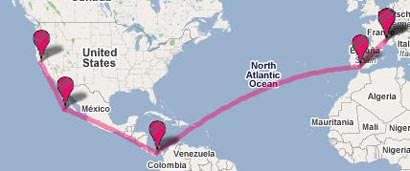Dr Vino's wine blog
wine talk that goes down easy
New Zealand wine stomps carbon footprint on the label
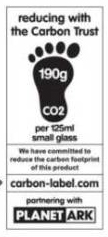 Starting early next year, some consumers will be able to buy a wine with a carbon footprint analysis on the label. Mobius, a new sauvignon blanc from New Zealand’s Marlborough region, will sport a calculation of greenhouse gas emissions on a per glass basis. Bottles destined for Australia will be the first to receive the notations; other markets will follow with custom calculations from the Carbon Trust, a nonprofit. The wine is made by New Zealand Wine Company, which also owns Grove Mill, run by emissions-guru Dave Pearce.
Starting early next year, some consumers will be able to buy a wine with a carbon footprint analysis on the label. Mobius, a new sauvignon blanc from New Zealand’s Marlborough region, will sport a calculation of greenhouse gas emissions on a per glass basis. Bottles destined for Australia will be the first to receive the notations; other markets will follow with custom calculations from the Carbon Trust, a nonprofit. The wine is made by New Zealand Wine Company, which also owns Grove Mill, run by emissions-guru Dave Pearce.
With so little space on the label, the graphic and number are helpful for a cursory indication. But it would be even more useful if carbon-label.org provided more information about the calculations. Hopefully the estimates will be conservative since, as my own research has shown, the mode of transportation matters as much or more than the actual distance traveled, making it difficult to put one number on a bottle for countries as big as Australia or the US, where a lengthy truck journey can add more to the GHG calculations than an even longer sea voyage.
Providing the methodology is acceptable, it is a step in the right direction. Given that wines entered in the Air New Zealand Wine Awards must now be certified “sustainable”, perhaps the industry will similarly provide some sort of carrot for other wineries to adopt carbon emissions labeling.
See the full label after the jump. Read more…
Tony Soter sheds some weight [carbon footprint]
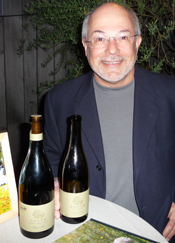 Tony Soter shed some unnecessary weight from one year to the next–in his bottles.
Tony Soter shed some unnecessary weight from one year to the next–in his bottles.
The Oregon vintner shipped his 2007 Pinot Noirs in bottles weighing 900g, more than the 750g of wine in the bottle. But for his 2008s, which are being released soon, the bottles will weigh 600g (both bottles, pictured right). Needless to say, the reduced packaging mass greatly reduces the carbon footprint of the wine.
“The time has passed that you can try to impress people with the substance of the bottle as opposed to what is in the bottle,” he said.
He also thought it odd to import tons of empty glass bottles from France, so started sourcing his bottles locally. One new facility near Portland is getting underway making recycled glass from hydro-electric power. Currently, he is sourcing the glass from Seattle. Other vintners in the area are also taking steps to make their bottles more lightweight, he said.
Here at the Dr. Vino World Headquarters, we raise an ultralight crystal stem of Willamette Valley Pinot Noir in their honor!
The carbon footprint of wine in National Geographic
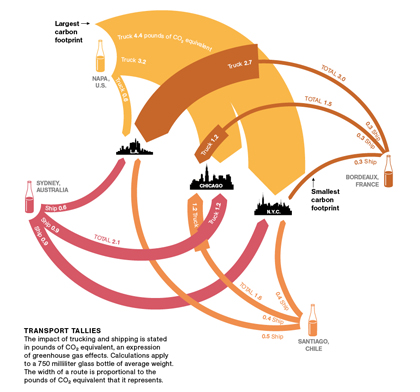
National Geographic has produced an excellent graphic in the May issue about wine’s carbon footprint (unfortunately, no link is yet available but the magazine is arriving in mailboxes and newsstands now). Pablo Paster and I provided the numbers for them based on our joint research on the subject.
We previously discussed the “green line” for wine and how it is more carbon efficient for a New Yorker to raise a glass of Bordeaux rather than a glass of California wine. Well, New Yorkers can now also raise a glass of Australian wine to achieve the same result: holding production method and bottle weight constant, the efficiencies of container shipping from a CO2e standpoint are such that a bottle of wine from Sydney arriving in New York City has a less than a quarter of the carbon emissions as one from California, which had a long journey by less efficient truck. The efficiencies even stretch to Chicago, assuming the bottle went through the Panama Canal to New Jersey and then had the shorter truck journey.
Astute readers will note that this finding was not in our original working paper. This updated version reflects the correction of a typo in one of our source materials (a reader of this site actually tipped us off to that), which, when corrected, made the efficiency of shipping even greater.
From Japan, observations about wine, carbon and classrooms
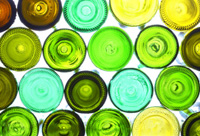 An MIT professor whose research focuses on energy and the environment is currently teaching Masters students in Sustainability Science at the University of Tokyo. He contacted my co-author and me about our research into the carbon footprint of wine since he wanted to assign his students the same task but tracking three bottles of wine to Tokyo instead of to Chicago, as we had done.
An MIT professor whose research focuses on energy and the environment is currently teaching Masters students in Sustainability Science at the University of Tokyo. He contacted my co-author and me about our research into the carbon footprint of wine since he wanted to assign his students the same task but tracking three bottles of wine to Tokyo instead of to Chicago, as we had done.
They tracked three hypothetical bottles from California, Australia and France and varied the mode of transport, with California going by air and the other two using shipping. Their results mirrored ours showing that the mode of transportation matters and that the mass of packaging also plays a role. Several students proposed that wine be shipped in bulk and bottled at the point of sale or consumption. He also added this detail:
The class discussion was concluded with an experimental component in which the students had the opportunity to sample a Yellowtail Cabernet Sauvignon (2005), Muscadet de Sevre and Maine (Loire, 2006), and a Ravenswood Zinfandel (2005, actually Sonoma + Mendocino but that is close enough to Napa). They agreed that (1) this made the assignment more interesting and (2) there are factors other than carbon emissions that should be taken into account when choosing wines.
I’m glad they enjoyed the research!
On a related note, the NYT ran a graphic with some of our findings in the excellent recent article, “Movable Feast Carries a Pollution Price Tag,” by Elisabeth Rosenthal.
New, alternative packaging resolves carbon footprint, food-wine dilemmas
In an effort to solve two of wine’s largest problems, the food pairing conundrum and the carbon footprint, Franzia has today announced the ideal solution: wine in an edible box.
The box is made from lightweight materials, which reduce the carbon dioxide emissions during transportation. But the packaging materials are also edible since they are made from a corn-based corrugated cardboard with a soy-based plastic bag on the inside. The wine brand is called Food n Wine Box.
“We wanted to do more than have a low carbon footprint,” said Anthony J. Franzia, Senior Vice President of Product Development, in a press release. “We wanted to have zero need for recycling the box and bag. With the packaging of Food n Wine Box, whoever squeezes off the last glass has the first dibs on digging into the delectable box.”
The boxes of the wine are available in different flavors. Robust Red has a hint of BBQ sauce embedded in its molecules. The Summer Sippin’ White has notes of grapefruit.
Chef Homaro Cantu was a consultant in the product design.
For more details, click here.
In Wine & Spirits talking about wine’s carbon footprint
Welcome readers of the Wine & Spirits magazine! If you’re looking for some bullet points and discussion of my research with Pablo Paster on wine’s carbon footprint, check here. Consider subscribing to the site feed or the monthly email updates on the right sidebar.
And if you haven’t seen the issue that is hitting mailboxes and newsstands now (but not the web), check out the Syrah extravaganza issue with reporting and reviews from Australia, the US (Santa Cruz), Chile and France. There’s also an interview on the back page that I did with editor and publisher Josh Greene.
While some of it covers familiar ground to blog readers, there’s some new material and great art (I wasn’t Simpsonized)! And I also make a proposal for later in the year: because air freight has such a big effect on a bottle’s carbon footprint and much Beaujolais nouveau is sent around the world by plane, how about saying no to nouveau and making the third Thursday of November a global celebration of local wine? Hit the comments with your initial thoughts on this idea. We’ll come back to it later in the year.
One point of clarification: the story ran a chart from our paper that reflects the various amounts of carbon dioxide emissions for bottles from different places. Napa looks horrible with even more than Australia! What was reflected in the text of the paper but didn’t make it into the chart in this story is that all the bottles were being sent to Chicago via differing modes of transport. The Napa one was sent sent by air. Sending it by truck would bring it down slightly below the CO2 emissions of the French bottle.
Carbonanalyzed: Blanquette de Limoux to Berkeley
Bonnie, the pun Queen from the excellent food blog, The Ethicurean, posted a comment requesting that we analyze the carbon footprint of her Blanquette de Limoux. She rides her bike to her local wine shop in Berkeley, CA to buy the sparkling white wine from the South of France.
We stopped our carbon analysis at the shop or restaurant and didn’t factor in how people get to the store. But there’s no beating the bike for reducing the carbon footprint, Bonnie!
Since she didn’t provide a producer name, which is fine, I’ve crunched the numbers based on a guesstimate rather than a specific case. Here’s the headline finding: Bonnie’s bottle produces just under 2600g of CO2 emissions, about the same as making and trucking a bottle of conventional wine from California to New York. More on the calculations after the jump. Read more…
Which wine would you like to see carbonanalyzed?
 My posting last week on the carbon footprint of wine has generated a good discussion around them there internets. But one thing is missing: the wines YOU want to have analyzed!
My posting last week on the carbon footprint of wine has generated a good discussion around them there internets. But one thing is missing: the wines YOU want to have analyzed!
So, in the comments below, have your say about wines you would like to have Pablo and me pour all over our carbon calculator. Let us know the wine name, winery location and where you will be consuming it. If possible, we would need to know the bottle weight (empty or full–the wine part always weighs the same).
Given our findings that transportation (coupled with glass bottles) makes up such a significant portion of the carbon footprint, it’s hard to say outright that one bottle is worse than another at face value. One of those ridiculously heavy bottles might not be so bad if it were made 50 miles from the winery and then consumed in the winery tasting room. But usually those are sent around the country (world) by air freight, which makes the biggest polluters.
Post here by Friday what you’d like to see us work on. We’ll pick one that seems popular or interesting and we will crunch the numbers over the weekend.
(image: istockphoto)

